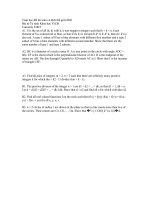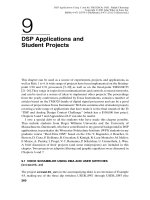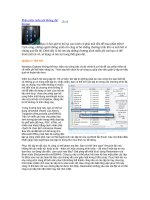Tài liệu Inequalities in Higher Education and the Structure of the Labour Market pdf
Bạn đang xem bản rút gọn của tài liệu. Xem và tải ngay bản đầy đủ của tài liệu tại đây (175.28 KB, 19 trang )
InequalitiesinHigherEducation
andtheStructureoftheLabourMarket
PercyMoleke
Free download from www.hsrcpress.ac.za
EmploymentandEconomicPolicyResearchProgramme,OccasionalPaper1
SeriesEditor:DrMiriamAltman,ExecutiveDirector:EmploymentandEconomicPolicyResearchProgramme
oftheHumanSciencesResearchCouncil
PublishedbyHSRCPress
PrivateBagX9182,CapeTown,8000,SouthAfrica
www.hsrcpress.ac.za
©2005HumanSciencesResearchCouncil
Firstpublished2005
Allrightsreserved.Nopartofthisbookmaybereprintedorreproducedorutilisedinanyformorbyanyelectronic,
mechanical,orothermeans,includingphotocopyingandrecording,orinanyinformationstorageorretrievalsystem,without
permissioninwritingfromthepublishers.
ISSN:1814-375X
ISBN:0-7969-2102-4
CoverbyJennyYoung
TypesettingandprintmanagementbyCompress
DistributedinAfricabyBlueWeaverMarketingandDistribution,
POBox30370,Tokai,CapeTown,7966,SouthAfrica.
Tel:+27+21-701-4477
Fax:+27+21-701-7302
Email:
Distributedworldwide,exceptAfrica,byIndependentPublishersGroup,
814NorthFranklinStreet,Chicago,IL60610,USA.
www.ipgbook.com
Toorder,calltoll-free:1-800-888-4741
Allotherinquiries,Tel:+1+312-337-0747
Fax:+1+312-337-5985
Email:
Free download from www.hsrcpress.ac.za
Preface
TheEmploymentandEconomicPolicyResearchProgrammeoftheHumanSciences
Research Council publishes this Occasional Paper series. The series is designed to
contribute to knowledge and stimulate debate on employment and unemployment
dynamics.Weinvitecommentsandresponsesfromreaders.
Free download from www.hsrcpress.ac.za
1
AbouttheAuthor
Ms Percy Moleke is a senior research specialist in the Employment and Economic
Policy Research (EEPR) Programme at the Human Sciences Research Council
(HSRC).SheholdsaMaster’sdegreeineconomicsfromtheUniversityofGeorgia.
MsMolekeisalaboureconomist.
Free download from www.hsrcpress.ac.za
1
InequalitiesinHigherEducationand
theStructureoftheLabourMarket
Introduction
TherelationshipbetweeneducationandeconomicgrowthanddevelopmentinSouth
Africahasbeenwidelystudiedanditsimportanceacknowledged.Highereducation
hasaparticularlyimportantroletoplayintheoveralldevelopmentoftheeconomy.It
hasovertheyearsprovidedsocietywithhighlyskilled,professionalworkersandmust
continuetodoso.Highereducationalsohasakeyroletoplayinextendingeducational
benefitstothedisadvantaged,thuscontributingtoequalopportunitiesandfairness.
However,fortheserolestoberealised,theeducationsystemhastobeeffectiveand
efficientwithimprovededucationoutcomes.Thechangingnatureoflabourmarkets
isplacingapremiumontechnicalexpertiseandoccupationalcompetenciesaswellas
onthematchingofeducationalqualificationswithprospectiveemployment.Allthis
has serious consequences for higher education, especially in the context of greater
demandforandwiderparticipationinhighereducation.
This paper looks at the inequities in higher education and their consequencesin
thelabourmarketforpeoplewithhighereducation.Theinequalitiesinthetypeand
sourceofhumancapitalacquiredareoftenoverlooked,anditisarguedherethatthey
perpetuateinequalitiesobservedinthelabourmarket.Inequitiesinacquiredhuman
capitaleventuallyinfluenceeducationalattainment,whichinturninfluenceslabour
marketprospects.Thisisreflectedintheselectionorsiftingofthepotentialemployees
inthelabourmarket.Thosewithlongeryearsofschoolinghavebetterprospectsin
thelabourmarket.Butalsoofsignificanceisthetypeofqualificationacquiredduring
schooling. Qualification differences translate into different types of skills acquired
– a major indicator of employability. These differences are increasingly accounting
forthecontinuingracialdisparitiesinthelabourmarket,particularlyinthecontext
of the growing demand for skilled labour. Whereas demand-side factors such as
discriminationintermsofphysicalappearance,i.e.raceandorgender,stillinfluence
employmentinSouthAfrica,thereisevidencethattheirimpactisdeclining.
The paper is part of the research on the employment experiences of university
graduates in South Africa. The research is based on a sample of 2 672 university
graduatesinSouthAfricawhoobtainedtheirqualificationsbetween1990and1998
acrossallfieldsofstudy.Thestudy–amailsurvey–wasconductedbetween1999
Free download from www.hsrcpress.ac.za
2
3
InequalitiesinHigherEducationandtheStructureoftheLabourMarket
and 2000. It is by far the most comprehensive tracer study of university graduates
everconductedinthecountry.Themainresearchdealswithvariousissuesrelatingto
thelabourmarketexperiencesofgraduates,eg.thetimeittooktofindthefirstjob,
period of unemployment, sector of employment, mobility between sectors (sectors
definedbroadlyasprivate,publicorself-employed),relationshipbetweenstudiesand
jobheld,furtherstudiescontemplatedandintentionstomoveabroad.
Education and the labour market prospects The occupational segregations
andinequalitiesinthe SouthAfrican labour market arearesultoftwophenomena
– discrimination and acquired human capital. The labour market is characterised
byracialjobsegregationbothbetweensectorsandbetweenoccupationalcategories.
For example, African and coloured workers have poorer economic outcomes than
theirwhiteandAsiancounterparts.Theyarelargelyconcentratedinthelessskilled
and less well-paid jobs, with limited upward mobility in either the internal or the
external labour market. Previous labour market policies deliberately restricted the
accessofAfricansinparticulartoskilledjobs,certainsectorsandcertainoccupational
categories.Pre-labourmarketdiscriminationthroughunequalprovisionofandaccess
to education and training reinforced the labour market policies. This ensured that
Africanswouldnotacquiretheskillsneededtoaccessprofessionaljobsandmoveup
thejobladder,eitherintheinternalorexternallabourmarket.This,inturn,affected
theirsocio-economicstatus.
Education, among other outcomes, improves the level of labour productivity by
enhancing individuals’ innate intellectual ability and equipping them with the ‘tools’
neededto be moreproductive at work.These tools includean increased capabilityfor
logicalreasoning,conceptualisation,communicationandothersoftskills,andmorespecific
jobskillsimpartedincoursessuchasaccounting,engineeringandmedicalscience.Hence,
businessmajorshavebetterjobprospectsthanhistorymajors,forexample,becausethey
haveskillsemployersarewillingtopaymoretoprocure.Accordingly,thosewithhigher
education qualifications have better economic prospects than those who do not. The
positivecorrelationbetweentheyearsofschoolingandhigherearningsissubstantiatedby
numerousstudies(Rospabe2001;Moll1996).
Nevertheless,differencesintheimpactofvarious‘skills’acquiredthrougheducation
on income and socio-economic outcomes are usually overlooked. More years of
schoolingundeniablyimplyabetterchanceofgainingemploymentthanfeweryears.
Butevenforthosewithsimilaryearsofschoolingtherearedifferencesineconomic
prospectsasaresultofdifferencesinacquiredskills.Inthecaseofindividualswhose
qualifications do notreflect the acquisition of specific professional skills, especially
thosewhoholdgeneralbachelor’sdegrees,theirqualificationsserveonlyasasignal
oftheirpotentialtoemployers.Inmanycases,theytakelongertorealiseemployment
andwhentheydotheirentryleveljobsdonotnecessarilyrequiretheyearsofschooling
theypossess.Theystartatthebottomofthejobladderandhavetoprovethemselves
inthelabourmarkettoreachhigherincomelevels.Acombinationoftheirpotential
andtrainingwilldeterminetheirprogressionuptheladder.Aswillbeseeninthenext
section,thefieldofstudy,whichsignalsthetypeofskillsacquiredthrougheducation,
playsasignificantroleinemployabilityofuniversitygraduatesinthiscase.
PercyMoleke
Free download from www.hsrcpress.ac.za
2
3
InequalitiesinHigherEducationandtheStructureoftheLabourMarket
Itisalsoacknowledgedthateducationisnottheonlyfactorthataccountsforinequities
inthelabourmarket.Thereisevidencethatthecorrelationbetweenschoolingandearnings
isweakerforsomesegmentsofthepopulationthanforothers(Keswell&Poswell2002).
There are differencesin thelabour market in terms of income and occupational status
acrossworkerswithsimilarobservablecharacteristics,eg.humancapitalandexperience,
butwithdifferentphysicalappearances,eg.raceand/orgender.Thesedifferencesarein
mostinstancestheresultofeconomicdiscrimination.Discriminationimpliesthatequally
productivegroupsdonotreceivesimilarrecognitionandcompensationfortheirproductive
characteristics.Whereasdiscriminationinthelabourmarketstillexistsandaccountsfor
someof the inequities,its effectis apparently declining. Van derBerg (2001) analysed
theimpactofqualityofschoolingoninequalitiesandarguedthattheresidualearnings
differentialsattributabletolabourmarketdiscriminationmightbesmallerthanthoughtif
cognisanceistakenofthelargedifferentialsineducationquality.Hefurtherarguedthat
labourmarketracediscriminationhasdeclinedasacauseofinequalitycomparedtoother
factorssuchaseducation,location,andfamilysizeandcomposition.
Variouslabourlaws,policiesandinitiativeshavebeenputinplacetoaddressthe
inequities in the labour market and in the education sector. In the labour market,
affirmative action laws and skills development laws have been enforced. The
Employment Equity Act (1998) seeks to ensure that people with equal observable
productivity skills are treated equally in the labour market. Complementing the
EmploymentEquityActistheSkillsDevelopmentStrategyof1998,whichseeksto
encouragetheprovisionofandaccesstotrainingwithinfirms,especiallytomembers
ofthepreviouslydisadvantagedcommunities.
Theselabourmarketinterventionshavegonealongwaytowardsaddressingtheexisting
disparities.However,despitetheconsiderableprogressmadeinachievingredress,inequities
arestillstark.Thisislargelybecausetheinterventionsfocusonthedemand-sidesources
of differences in economic outcome. The inequities in education – higher education in
particular–areinextricablylinkedtothelabourmarketstructure.Theytoalargeextent
determinetheprospectsofgraduatesasjob-seekers.Actualandperceivedqualitydifferentials
ineducationandinvarioustypesofqualificationsaccountformostoftheinequitiesinthe
labourmarket.Africanstendtostudyinfieldswithpoorereconomicandlabourmarket
outcomes,eg.thehumanitiesandarts-relatedfields.Inmanycases,thisisnotbecausethey
chooseto.ManyAfricansareconstrainedbytherequirementsofvariousdepartmentsin
highereducationinstitutions,lackoffinanceandpooracademicbackgrounds,allofwhich
makeitdifficultforthemtocopeandsuccessfullycompletetheirstudies.Somearealso
constrainedbyalackofcareerguidanceandaccesstoreliablelabourmarketinformationto
assistthemtomakeinformeddecisionsbeforeenteringhighereducation.
InequitiesineducationTheeducation structurereflectsthelegacyofapartheid.
Whereas Africans’ participation in primary, secondary and higher education has
increased,theystilllagbehindineducationalattainmentbecauseofthecontinuing
severeinequalitiesinsomeareas.Educationprovisioninmanypublicschoolsisstill
ofpoorquality.DropoutandrepetitionratesamongAfricansremainhighatprimary
and secondary school level, with many learners dropping out of secondary school
beforetheycanwritetheseniorcertificateexam(Perry2003).
Free download from www.hsrcpress.ac.za
4
PercyMoleke
5
InequalitiesinHigherEducationandtheStructureoftheLabourMarket
Despitetheobservedsignificantincreasesinthenumberofseniorcertificateholders
inthepastdecade,theproportionoflearnerswhoactuallysitfortheexamremains
low.Thequalityoftheseniorcertificateexamalsocontinuestobeofconcern.The
largemajorityoflearnersstillopttowritetheseniorcertificateexamonthestandard
graderatherthanonthehighergrade.Consequently,theproportionofthosepassing
with endorsement – which is a requirement for admission to universities – and in
mathematicsandscience,remainslow.Itisestimatedthatoftheaverageof460000
learnerswhosatforthesenior certificate exam between 2000and2002, only 14%
enteredpublichighereducation(universitiesandtechnikons).Itisfurtherestimated
that about 37% of these candidates who sat for senior certificate exams failed and
15% dropped out (Subotzky 2003). The proportion of those obtaining a senior
certificatepassinmathematicsandscienceisevenlower.Theproportionoflearners
whopasstheseniorcertificateexamwithendorsementconstitutesasignificantinflow
into higher education institutions, particularly universities. Although technikons
also require senior certificate endorsement, they do enrol a significant proportion
of students without a senior certificate endorsement, and a number of university
departmentsalsomakeconcessionsanddothesame.
Theimprovementsobservedwithregardtoseniorcertificatepassratesarereflected
in increases in enrolment rates in higher education. Enrolment rates of Africans
increasedto60%in2002(provisionalfigures)from29%in1988comparedtowhites
whoseenrolmentratesdeclinedfrom58%to28%duringthesameperiod(Subotzky
2003). However, enrolmentpatternsby fieldofstudy stillshowa biastowardsthe
humanities and arts relative to other fields. For example, in 2000, university and
technikonenrolmentsshowthat50%ofthoseenrolledwereinthehumanitiesand
social sciences, while science, engineering and technology, and business, commerce
andmanagementscienceshad26%and24%enrolmentsrespectively.Table1below
indicatesthatthehumanities and socialsciencesgraduatescontinueto constitutea
higherproportionofthosewhograduatefromuniversitiescomparedtootherfields
of study. Also of concern is the fact that many students either drop out of higher
educationwhileotherstakelongertoobtaintheirqualification.Thechallengeisto
increase completion rates of those who enter higher education. It is estimated that
in2000-2001,only14%ofthoseenrolledactuallycompletedtheircourseofstudy.
Ofthosewhodidnotcompletetheircourseofstudy,only70%returnedwhile15%
dropped out (Subotzky 2003). It is not clear if those who returned did eventually
complete their course of study. Nevertheless, this shows that there is a significant
proportionofdrop-outsinhighereducation.
Table1:UniversitygraduationsbyClassificationEducationalSubjectMattergroup,
1995–2001
CESMgroup 1995 1996 1997 1998 2000 2001
SET 11800 11800 12300 12900 15500 16135
BC 11000 10500 11200 11600 12400 13225
HSS 28700 28100 30700 30400 39100 42992
Total 51500 50400 54200 54900 67000 72352
Sources:1995–1998:Cloete&Bunting(2000);2000:DoE(2000,2001a)(citedfromSubotzky2003)
Free download from www.hsrcpress.ac.za
4
PercyMoleke
5
InequalitiesinHigherEducationandtheStructureoftheLabourMarket
The 2002 enrolment figures attest to the improvements observed in secondary
schooling.Overall,theproportionsofthoseenrolledinvariousfieldsofstudyshow
amoveawayfromaconcentrationofgraduatesinhumanitiesandarts-relatedfields
and an improvement in enrolments in science, engineering and technology-related
fields,andinbusinessandcommerce.Thesefiguresalsoshowashiftwithregardto
race.ThereisanincreaseinAfricansenrollinginthefieldsofscienceandbusinessand
commercerelativetothosewhoenrolinthehumanitiesandarts.However,itremains
tobeseeniftheseenrolmentrateswilltranslateintosimilarproportionsingraduation
ratesinthecomingyears.
Table2:EnrolmentdistributioninthreeDepartmentsofEducation’sfieldsofstudy,by
populationgroup,2002
Fieldofstudy Africans Coloureds Indians Whites Total
Humanities 25,4 38,1 27,5 41,1 31,4
Businessandcommerce 40,0 27,2 27,6 20,6 32,0
SET 34,6 34,7 44,9 38,3 36,6
Total 100,0 100,0 100,0 100,0 100,0
(citedfromCosser2004)
Notes:
1 Datafor2000arenotavailablefortheUniversityofNorthWest.
2 TotalsherearelowerthaninTable2astheyarebasedondifferentdataavailableatthetime.Variousestimatesof
enrolmentsmadeatdifferenttimesproducedslightlydifferentconclusions,basedontheavailabledataatthetime.
TheDoEfiguresareconstantlyrevised.
GraduateprospectsThosewhomanagetoobtainahighereducationqualification
have a better chance in the labour market than those who do not. A skill bias is
clearlyevidentwhere,despitethehighunemploymentrateinthegeneralpopulation,
the unemployment rate of individuals with higher education qualifications is
relatively low. However, not all of these people are successfully and satisfactorily
absorbed.Highereducationqualificationsdonotnecessarilytranslateintoimproved
job prospects, although one is more likely to have better job prospects with such
qualificationsthanwithoutthem.
The inequalities in educationare inextricablylinked tothe labourmarket structure.
Thisstructuredeterminestheexpectationsthathighereducationgraduateshaveasjob-
seekers. Inequalities in higher education, namely differentiation between and within
various institutions and between and within various disciplines, are directly linked to
the differentiation between various occupations in the labour market. The clustering
of graduates (mostly Africans) in the humanities and social sciences fields perpetuates
the segmentation of the labour market as it was when previously racially determined.
Graduates in these fields of study have poor labour market outcomes. They are thus
relegatedtoinferiorpositionsinthelabourmarket,withlowereconomicprospectsand
littlechanceofmobilityineithertheinternalorexternallabourmarket.
Employment The results of the tracer study used in this paper attest to the low
unemployment rate of graduates, which is also reported by other national studies.
Inthisstudy,itwasfoundthat60%ofgraduatessecuredemploymentimmediately
1
Free download from www.hsrcpress.ac.za
6
PercyMoleke
7
InequalitiesinHigherEducationandtheStructureoftheLabourMarket
afterqualifying,afurther28%securedemploymentbetweenamonthandsixmonths
afterqualifying,6%didsobetween7and12monthsafterqualifying,and6%took
morethat ayear tofindemploymentafter obtainingtheir qualifications.However,
racialsegmentationinthegraduatelabourmarketisevidentlargelybecausewhiteand
AsiangraduatesengageindifferentlabourmarketprocessescomparedtoAfricansand
coloureds.
Naturally,fieldofstudyplaysamajorroleinsecuringemployment.Merelyhaving
auniversityqualificationisnotgoodenoughasvariousdegreesimpartdifferentskills
to graduates, thus sending different signals to potential employers. Graduates in
fieldswithamoreprofessionalfocus,suchasmedicalsciences(79%)andengineering
(77%),foundemploymentmorequicklythanthosewhostudiedinfieldsofageneral
nature(Table3).
Table3:Periodbeforefindingemployment,byfieldofstudy
Fieldof
study
Immediately
%
Between
1&6
months
%
Between
7&12
months
%
Between
1&2
years
%
Morethan2
years
%
Total
%
Naturalsciences 55,0 38,8 3,8 2,1 0,4 100
Engineering 77,2 18,3 3,0 1,0 0,5 100
Agriculture 61,6 31,4 5,8 1,2 0,0 100
Medicalsciences 79,3 18,5 2,2 0,0 0,0 100
Humanities
andarts
46,8 33,1 8,5 7,3 4,2 100
Education 57,0 33,8 3,9 4,4 0,9 100
Law 49,6 30,2 8,6 7,2 4,1 100
EMS* 65,4 23,3 6,2 3,7 4,3 100
Total 59,5 28,4 5,9 4,2 2,0 100
*EMS:Economicandmanagementsciences
In a labour market marked by disparities and inequities, factors such as race and
gender can be expected to play a significant role in employability. With respect to
race,althoughAfricanswereconcentratedinfieldsofstudywithpooreremployment
prospects,acomparisonwithinthestudyfieldsindicatedthattheirwhitecounterparts
hadbetter prospects.Forexample,white graduates constituted ahigher proportion
(70%) of those who found immediate employment compared with 57, 8% of
Africans,57% ofcolouredsand52%ofAsians.Inotherwords,withinstudyfields
the differences varied according to race. More than 50% of white graduates found
immediateemploymentinallstudyfields,whereastheonlyfieldswheremorethan
50% of Africans found employment immediately were engineering (88%), medical
sciences(66%)andagriculture(53%).ItwasonlyinengineeringthatAfricangraduates
experiencedthehighestproportion(88,9%)ofthosesecuringimmediateemployment
comparedto78,3%,50%and50%forwhites,Asiansandcolouredsrespectively.The
Free download from www.hsrcpress.ac.za
6
PercyMoleke
7
InequalitiesinHigherEducationandtheStructureoftheLabourMarket
disadvantageofAfricansandcolouredsinthelabourmarketemergedclearlyinthis
analysis.Infieldswithaprofessionalfocus,insignificantdifferencesexistedinterms
of being absorbed into the labour market, but significant differences were evident
in general fields such as the humanities and arts, and economic and management
sciences(Table4).
Table4:Proportionofgraduatesemployedimmediately,byrace
Fieldofstudy Asian
%
African
%
Coloured
%
White
%
Naturalsciences 30,0 45,9 52,2 59,9
Engineering 50,0 88,9 50,0 78,3
Agriculture 53,3 83,3 64,3
Medicalsciences 46,0 65,7 32,5 91,2
Humanitiesandarts 53,6 38,7 33,3 56,4
Education 71,4 49,3 28,6 75,0
Law 36,4 26,8 51,6 69,6
EMS* 53,5 37,5 42,2 74,8
Total 47,6 43,0 42,2 70,4
*EMS:Economicandmanagementsciences
Gender,ontheotherhand,seemedtoshowinsignificantdifferences.Althoughahigher
proportionofmenwereabsorbedintothelabourmarketmorequicklythanwomen,a
significantnumberofwomenwereabsorbedfairlyquickly.Itwasonlyinthehumanities
andartsandinlawwherelessthan50%ofthewomenfoundemploymentimmediately,
althoughinthehumanitiesandartsthemenhadasimilarexperience(Table5).
Table5:Periodbeforefindingemployment,bygender
Fieldof
study
Immediately Between
1&6
months
Between
7&12
months
Between
1&2
years
Morethan
2
years
Male Female Male Female Male Female Male Female Male Female
Natural
sciences
58,7 50,9 35,7 42,1 3,2 4,4 1,6 2,6 0,8
Engineering 78,5 70,0 16,9 26,7 3,5 0,6 3,3 0,6
Agriculture 67,3 54,1 28,6 35,1 2,0 10,8 2,0
Medical
sciences
81,3 78,5 16,0 19,5 2,7 2,1
Humanities
andarts
48,0 46,1 30,2 34,9 8,2 8,8 7,5 7,2 6,0 3,1
Education 54,9 58,7 32,4 34,9 6,9 1,6 3,9 4,8 2,0
Law 50,0 49,2 25,0 37,3 8,8 8,5 8,8 5,1 7,5
EMS* 67,9 62,6 18,4 29,0 8,2 3,8 3,6 3,8 2,0 0,8
Total 62,3 57,0 24,7 31,9 6,3 5,5 3,9 4,4 2,8 1,3
*EMS:Economicandmanagementsciences
Free download from www.hsrcpress.ac.za
8
PercyMoleke
9
InequalitiesinHigherEducationandtheStructureoftheLabourMarket
Of particular interest are the differences stemming from institution attended and
the rate at which these graduates are absorbed into the labour market. Differences
by institution attended indicate that graduates from historically white universities
(HWUs) had better employment prospects than those from historically black
universities (HBUs). This is partly due to employer perceptions regarding the
quality of education at historically black universities. It could also be explained by
HBUshavingdisproportionatenumbersofstudentsgraduatinginfieldswithlower
employmentprospects,i.e.thehumanitiesandarts,andeducation.Overall,ofthose
whofoundemploymentimmediately,onlyabout40%werefromHBUscomparedto
69%fromHWUs.Whilefieldofstudypartlyexplainsthesedifferences,indications
ofdisadvantageforthosegraduatingfromHBUsarealsoevident.Forexample,the
lawgraduatesfromHBUsandfromHWUshaddifferentlabourmarketexperiences
– 27% of HBU graduates found employment immediately compared to 67,5% of
their HWU counterparts. In economic and management sciences, the figures were
38,5%forHBUsand73,5%forHWUsrespectively.
Table6belowclearlyshowsthedisadvantageexperiencedbystudentsfromHBUs.
HigherproportionsofstudentsfromHWUsareabsorbedinthelabourmarketfairly
quickly(withinsixmonthsofgraduating)whereasthosefromHBUstakelongerto
findemployment.Itislikelythatinstitutionsserveasasignalinthelabourmarket
in terms of which graduates from HWUs are assumed to have characteristics that
correlatewithhigherperformanceinthelabourmarket,comparedtograduatesfrom
HBUs.Inthecontextofaskillsshortage,thisconstitutesasubstantialwasteinthe
highereducationsysteminsofarasitserveslabourmarketneedsforbothjob-seeker
andtheeconomy.
Table6:Periodbeforefindingemployment,byfieldofstudyandinstitutionattended
Fieldofstudy Immediately Between
1&6months
Between
7&12months
Between
1&2
years
Morethan
2
years
HBU
%
HWU
%
HBU
%
HWU
%
HBU
%
HWU
%
HBU
%
HWU
%
HBU
%
HWU
%
Naturalsciences 40,0 59,5 47,3 36,2 10,9 1,6 1,8 2,2 0,0 0,5
Engineering 60,0 77,7 20,0 18,3 0,0 3,0 20,0 0,5 0,0 0,5
Agriculture 53,3 63,4 33,3 31,0 13,3 4,2 0,0 1,4 0,0 0,0
Medical
sciences
57,3 88,8 37,8 10,1 4,9 1,1 0,0 0,0 0,0 0,0
Humanities
andarts
34,0 55,8 36,3 30,9 10,9 6,9 11,2 4,6 7,6 1,8
Education 49,7 72,6 38,1 24,7 5,8 0,0 5,2 2,7 1,3 0,0
Law 27,4 67,5 37,1 24,7 14,5 3,9 12,9 2,6 8,1 1,3
EMS* 38,5 73,5 26,9 22,2 16,9 3,0 13,1 0,9 4,6 0,5
Total 40,5 68,8 35,9 24,8 10,5 3,6 8,6 2,0 4,5 0,8
*EMS:Economicandmanagementsciences
Free download from www.hsrcpress.ac.za
8
PercyMoleke
9
InequalitiesinHigherEducationandtheStructureoftheLabourMarket
LevelsatwhichgraduatesfunctioninthelabourmarketNaturally,itwould
beexpectedthatgraduateswouldholdjobscommensuratewiththeirstudies.These
jobs would generally fall within the professional level and above. While in all race
groups there were more graduates in professional jobs, whites made upthe highest
proportion (23,6%) of those in managerial positions, followed by Asians (19,6%),
Africans(10,8%)andcoloureds(10,6%)(Table7).
Table7:Leveloffunction,byrace
Leveloffunction Asian African Coloured White Other
Managerial 19,6 10,8 10,6 23,6 21,4
Supervisory 6,3 7,7 8,1 4,4 7,1
Professional/Technical 63,9 59,9 55,0 57,2 67,9
Administrative 5,1 13,1 16,3 10,4
Operator 0,6 3,8 3,1 0,8 3,6
Trainee 4,4 4,6 6,9 3,5
Total 100,0 100,0 100,0 100,0 100,0
Itcouldbeexpectedthattheperiodspentinthelabourmarketwouldheavilyinfluence
the level atwhich graduates function.This would beespecially so forhigher levels of
employment such as management. An investigation of those who indicated that they
werefunctioningatmanagementlevelandthenumberofyearstheyhadworkeddidnot
revealanydifferencesthat mightaccountformorewhiteandAsiangraduatesbeingin
management compared to theirAfrican and colouredcounterparts. The proportionof
whiteandAsiangraduateswithineachcategoryofnumberofyearsworkedwasnotashigh
asthatofotherracegroupsatthetimeofthesurvey(Table8).
Table8:Numberofyearsworkedbythoseinmanagement,byrace
Numberofyearsworked
Asian African Coloured White
0–5years
46,7 34,4 58,8 38,6
6–10years
36,7 50,8 35,3 51,8
11–15years
16,7 14,8 5,9 7,5
SectorofemploymentTheroleofthepublicsectorasanemployerisofparticular
interest.Itisthefirstsectorofemploymentforalargeproportionofgraduatesirrespective
offieldofstudy,raceandgender.ThisisespeciallytrueforAfricangraduateswhomake
up higher proportions ofthose employed inthis sector. Asgraduates changejobs and
sectorsofemployment,Africansandcolouredrepresentationinthissectorincreaseswhile
thatofAsiansandwhitesdecreases.
Differenceswereevidentintermsoflevelsatwhichgraduatesfunctioninthesesectors.
WhiletheproportionsofwhitesandAsiansinprofessionallevelswerehigherinthepublic
sector(71,5%and79,4%respectively),almostequalproportionsofthosefunctioningat
manageriallevelswereapparentforallracegroups.However,whenonelooksattheprivate
Free download from www.hsrcpress.ac.za
10
PercyMoleke
sector, not only is the proportion of those functioning at professional levels higher for
whites and Asians (51% and 47,8% respectively), but their proportions in management
are higher as well (about 27% for both race groups), compared to Africans and coloureds
(11,9% and 9,7% respectively) (Table 9).
Table9:Leveloffunctionwithinsectorofemployment
Race
Managerial
%
Super-
visory
%
Professional/
Technical
%
Admini-
strative
%
Operator
%
Trainee
%
Publicsector
Asian 8,8 5,9 79,4 2,9 1,5 1,5
Black 10,3 8,2 63,8 11,6 2,9 3,2
Coloured 11,0 9,9 58,2 9,9 3,3 7,7
White 10,2 5,1 71,5 9,5 3,6
Privatesector
Asian 27,5 7,2 47,8 8,7 8,7
Black 9,8 6,5 42,4 21,7 7,6 12,0
Coloured 11,3 6,5 46,8 25,8 3,2 6,5
White 27,2 4,4 51,1 12,1 1,2 4,0
Self-employed
Asian 26,3 5,3 68,4
Black 38,5 46,2 7,7 7,7
Coloured 100,0
White 39,1 1,8 52,7 4,1 1,2 1,2
90.0
80.0
70.0
60.0
50.0
40.0
30.0
20.0
10.0
0.0
47.0
51.2
23.0
76.7
0.3
56.6
2.2
1.2
39.0
39.0
3.6
1.8
Publicsector PrivatesectorSelf-employment
Asian
Black Coloured White
Figure1:Sectoroffirstjob,byrace
Source:Moleke2004
Free download from www.hsrcpress.ac.za
10
PercyMoleke
11
InequalitiesinHigherEducationandtheStructureoftheLabourMarket
The survey also looked at the movement of graduates between public and private
employmentandself-employment.Generally,itwasmainlyAsianandwhitegraduates
whomovedinto self-employmentand,even then,mainly thoseinthemedical and
legalfields.Overall,onlyasmallproportionofgraduatesinthesurveywereinself-
employment.Themovementbetweenthepublicandprivatesectorwasmuchmore
significant.Thepublicsectorisanimportantfirstemployer,particularlyforAfrican
graduates.Otherracegroupstendtofindsubsequentjobsintheprivatesector,while
Africangraduatestendtoremaininpublicsectoremployment.Thepublicsectoris
cruciallyimportantforAfricangraduates–76,7%oftheAfricangraduatessurveyed
found their first job in the public sector. This proportion rose to 82% of those
reportingontheircurrentjob(compareTable10andTable11).
Table10:Firstjobbysector,populationgroupandfieldofstudy
Race
Natural
sciences
Engi-
neering
Agri-
culture
Medical
sciences
Humanities
andarts
Edu-
cation
Law EMS* Total
Asian
Public 60,0 37,5 100,0 55,1 62,1 100,0 9,1 23,3 47,0
Private 40,0 62,5 42,9 34,5 90,9 74,4 51,2
Self-employed 2,0 3,4 2,3 1,8
African
Public 79,5 33,3 86,7 65,7 82,6 89,4 51,2 54,1 76,7
Private 20,5 66,7 13,3 31,4 17,4 10,6 48,8 44,7 23,0
Self-employed 2,9 1,2 0,3
Coloured
Public 47,8 81,8 64,9 81,8 42,9 37,9 56,6 56,6
Private 47,8 100,0 18,2 33,8 18,2 57,1 62,1 42,2 42,2
Self-employed 4,3 1,4 1,2 1,2
White
Public 47,1 31,3 36,6 62,7 44,0 72,7 43,3 18,5 39,0
Private 52,3 63,7 49,3 34,9 52,5 22,7 55,2 78,7 57,5
Self-employed 0,6 5,0 14,1 2,4 3,5 4,5 1,5 2,8 3,6
*EMS:Economicandmanagementsciences
PerceptionsofthevalueofhighereducationThegraduateswereaskedifthey
would choose the same or a different course of study if they could start again, to
establish the value theyplaced on higher education. Interestingly, 48,6% said they
wouldchoose a different courseof study,while 49%indicatedthat they woulddo
thesamecourseagain.Only1,6%indicatedtheywouldnotenterhighereducation
atall.Thus,whilemostofthegraduatesrealisedthevalueandimportanceofhigher
education,theyappearedtomakelessinformeddecisionsontheirchoice of study.
Thisvariedfordifferentstudyfields.Whileallfieldshadgraduateswhoindicatedthat
theywouldchooseadifferentcourseofstudy,mostofthesewereinthehumanities
andarts(63%)andeducation(69,7%)(Table12).
Free download from www.hsrcpress.ac.za
12
PercyMoleke
13
InequalitiesinHigherEducationandtheStructureoftheLabourMarket
Table11:Currentjobsector,byraceandfieldofstudy
Race
Natural
sciences
Engi-
neering
Agri-
culture
Medical
sciences
Humanities
andarts
Edu-
cation
Law EMS* Total
Asian
Public 50,0 28,6 40,0 70,4 80,0 18,2 34,9 43,9
Private 44,4 71,4 100,0 40,0 22,2 45,5 60,5 43,9
Self-employed 5,6 20,0 7,4 20,0 36,4 4,7 12,1
African
Public 70,6 62,5 100,0 68,6 86,5 96,1 64,9 64,0 82,0
Private 29,4 37,5 14,3 11,9 3,9 27,0 34,9 15,7
Self-employed 17,1 1,6 8,1 1,2 2,4
Coloured
Public 54,5 50,0 62,9 100,0 41,7 46,7 57,1
Private 40,9 100,0 41,7 35,7 33,3 53,3 39,1
Self-employed 4,5 8,3 1,4 25,0 3,7
White
Public 35,9 19,6 26,8 35,2 38,2 61,9 24,6 16,4 29,0
Private 56,9 69,8 47,9 46,9 50,8 22,2 59,4 74,5 59,0
Self-employed 7,2 10,6 25,4 17,9 11,0 15,9 15,9 9,1 12,0
*EMS:Economicandmanagementsciences
Table12:Hypotheticalre-enrolment,byfieldofstudy
Fieldofstudy Samecourse Differentcourse Notenter
highereducation
Total
Naturalsciences 54,5 43,2 2,3 100,0
Engineering 63,4 36,1 0,5 100,0
Agriculture 55,1 42,7 2,2 100,0
Medicalsciences 57,4 42,6 100,0
Humanitiesandarts 35,0 63,0 2,0 100,0
Education 27,5 69,7 2,8 100,0
Law 55,6 42,4 2,0 100,0
EMS* 66,8 32,1 1,0 100,0
Total 49,8 48,6 1,6 100,0
*EMS:Economicandmanagementsciences
Asurveyoftheactualsituationrevealedthat22,3%ofthosewhostudiedfurtherafter
obtaining their first degree changed their study field. The humanities and arts had
thehighestproportion(41,9%)ofthosewhochangedfieldswhenstudyingfurther,
withthenextfield ofstudy beingnaturalsciences(12,9%).Although thismaynot
be conclusive, it shows the lower employability of the majority of those who hold
humanitiesandartsqualificationsandhencetheneedforthemtochangetheirfieldof
studywhenpursuingfurtherstudies.Itmayalsobeanindicatorofbadchoicesmade
duetolackofinformationpriortopursuinghighereducationstudies.This,however,
Free download from www.hsrcpress.ac.za
12
PercyMoleke
13
InequalitiesinHigherEducationandtheStructureoftheLabourMarket
isnottosuggestthatpeoplepursuehighereducationandfurtherstudiespurelyfor
thepurposeoffindingajob,ascontinuouseducationoccursalsoaspartoflifelong
learning.
SummaryandconclusionCurrentracialinequitieshavetheirrootsinpastracial
injustices. The continuing racial differences in economic outcome are evident.
Africanscontinuetoberelativelydisadvantagedcomparedtotheirwhitecounterparts.
Racial discrimination played a major role in the creation of these inequities, and,
accordingly, various measures and initiatives have been introduced to redress the
situation. However, they are not sufficient to eliminate disparities in the labour
marketbasedonraceastheyprimarilyaddressthedemand-sidesourcesofinequities.
Thecontinuingdisparitiespointtoaneedtolookintotheroleofsupplyfactorsin
thephenomenon.Differencesinhumancapitalacquiredaregainingprominencein
accountingfortheracialdisparitiesinthelabourmarket.
Field of study is the major determinant of employability for those with higher
education qualifications. Those in fields of study that lead to a profession and
those whose fields of study are perceived positively by potential employers tend
to find employment quicker. The authorities have endeavoured to improve the
participationofpreviouslydisadvantagedindividualsinfieldsthatwillpreparethem
forprofessionaljobsalignedtolabourmarketneeds.Itis,however,notgoodenough
toholdahighereducationqualification–thetypeandqualityofthequalificationis
evenmoreimportant.
Race continues to play a role in employability in South Africa, irrespective of
thefieldofstudy.Even withinthesamefieldofstudy,whitegraduateshavebetter
prospects than their African counterparts. However, the impact of race seems to
be minimal when all other factors are taken into account. Of particular interest
is the role played by the institution attended. Students from HBUs tend to have
lower employment prospects and to take longer to find employment compared to
students from HWUs. Institutional characteristics partly explain these differences.
For example, HBUs generally produce graduates in the humanities and arts whose
labourmarketoutcomesarecomparativelypoor(thisisnotuniquetoSouthAfrica).
ThelargemajorityofthesegraduatesareAfrican.Hence,tosomeextent,itwouldbe
expectedthattheseinstitutionswouldshowlowerlevelsofsuccesswithregardtothe
employabilityoftheirgraduates.However,thereareunexplaineddifferencesaswell.
Irrespectiveoffieldofstudy,raceorgender,studentsfromHWUsseemtohavemore
successinthelabourmarket.Apossibleexplanationofthesedifferencesmaylieinthe
differingqualityofeducationintheseinstitutions,whetherperceivedorreal.
Differences were also noted in sector of employment,revealing a divide along racial
andqualification-typelines.Thepublicsectorseemedtoplayakeyroleasanemployer
ofgraduates,particularlyAfricans.FewerAfricansswitchedjobsfromthepublictothe
privatesectoratthetimeofthesurvey,whilewhitesswitchedfromthepublictotheprivate
sectorandtoself-employment.Itisalsointerestingtonotethatinthepublicsectorsimilar
proportions of all racegroups functioned at managementlevel, whereasin theprivate
sectormorewhitesandAsiansweremanagerscomparedtoAfricansandcoloureds.
Thedifferencespointedouthereindicatethatincreasingparticipationrates,whether
Free download from www.hsrcpress.ac.za
14
PercyMoleke
15
InequalitiesinHigherEducationandtheStructureoftheLabourMarket
ineducationorinthelabourmarket,havedonelittletoaddresstheinequalitiesof
the past.Thelackoflabour marketinformation andproper careerguidancein the
earlyyears of schooldoeslearners nojustice.Many graduates areat a disadvantage
duetotheirownill-informeddecisionswithregardtostudychoice,prioreducation
and access to an institution or course of study. Perceptions of potential employers
aboutthequalityofeducationinvariousinstitutionsalsoplayanimportantrolein
employability.Effortsmustbemadetochangetheseperceptions.Althoughthedivide
betweeninstitutionsofhighereducationisnolongeralongraciallinesasthenumber
ofAfricansinhistoricallywhiteinstitutionshasrisen,thehistoricallypredominantly
blackinstitutionsarestillpredominantlyblackdespitethemergers.Itremainstobe
seenifthemergerswilldoanythingtochangeprevailingperceptions.
Clearly,highereducationhasamajorroletoplayinlabourmarketre-adjustment,
particularly in terms of countering and averting segmentation of the labour force.
Becauseoftheever-growingdemandforhighlyskilledpeople,particularlyinthefields
ofscienceandtechnology,apolicyinterventionisrequiredthatwillradicallyimprove
thequalityofthedeliveryoftheeducationsystem.Enhancingeducation’sproductive
anddistributivefunctionsshouldbeapriorityofthe authorities.Educationshould
not only provide all the skills and competencies needed in a changing economy;it
shouldalsoensurethatsectionsofthepopulationarenotleftbehindbecauseoflack
ofappropriateskillsandqualifications.
Endnote
1 Employmentimmediatelyinthisstudyisdefinedasfindingajob/employmentimmediatelyafterobtaininga
degree.Thisimpliesthatnounemploymentwasexperiencedbythesegraduates.
Free download from www.hsrcpress.ac.za
14
PercyMoleke
15
InequalitiesinHigherEducationandtheStructureoftheLabourMarket
References
Cosser,M,DuToit,J&Visser,M(2004)Dreamingofahighereducation.Grade12learners’destinationsone
yearon,HSRCresearchmonograph
Keswell,M&Poswell,L(2002)ReturnstoeducationinSouthAfrica1996–2000,CSSRworkingpaper
Moll,P(1996)ThecollapseofprimaryschoolingreturnsinSouthAfrica1960–1990,OxfordBulletinof
EconomicsandStatistics58:185–209
Moleke,P(2004)Findingwork:EmploymentexperiencesofSouthAfricangraduates,HSRCmonograph
Perry,H&Arends,F(2003)PublicschoolinginHumanResourcesDevelopmentReview2003:Education,
EmploymentandSkillsinSouthAfrica,CapeTown:HSRCPress
Rospabe,S(2001)Anempiricalevaluationofgenderdiscriminationinemployment,occupationalattainmentand
wagesinSouthAfricainthelate1990s,PaperpresentedattheDPRU/FESConferenceonLabourMarketsand
PovertyinSouthAfrica,Johannesburg,15–16November
SubotzkyG(2003)PublichighereducationinHumanResourcesDevelopmentReview2003:Education,
EmploymentandSkillsinSouthAfrica.CapeTown:HSRCPress
VanderBerg,S(2001)Theroleofeducationinlabourearnings,povertyandinequality,Paperpresentedatthe
DPRU/FESConferenceonLabourMarketsandPovertyinSouthAfrica,Johannesburg,15–16November
Free download from www.hsrcpress.ac.za









